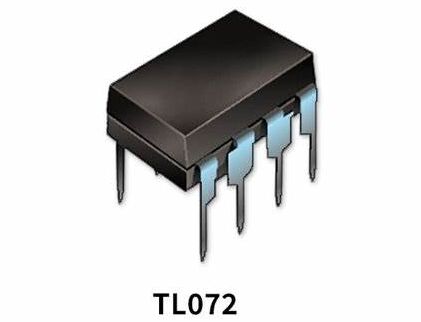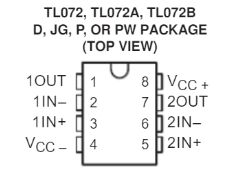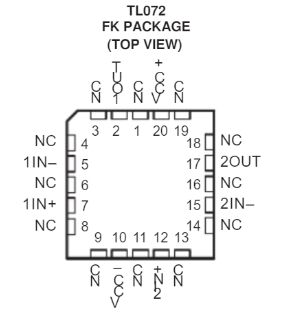By Texas Instruments 200
TL072 is a dual-channel low-noise operational amplifier (Op-Amp) model. It is an integrated circuit commonly used in electronic circuits for signal amplification and processing. The TL072 is one of the common models produced by several semiconductor manufacturers such as Texas Instruments.
TL072 is a high-power field effect tube output dual op amp that uses high voltage field effect tubes and bipolar tubes. This component has fast switching speed, small input bias voltage and offset current, and low offset voltage temperature coefficient.
The TL07xH (TL071H, TL072H, and TL074H) family of devices are the next-generation versions of the industry-standard TL07x (TL071, TL072, and TL074) devices. These devices provide outstanding value for cost-sensitive applications, with features including low offset (1 mV, typical), high slew rate (20 V/μs), and common-mode input to the positive supply.

Ⅰ.Specification parameters of TL072
•Product Category:Operational Amplifier-Operational Amplifier
•Installation style:Through Hole
•Package / Box:PDIP-8
•Number of channels:2 Channel
•GBP-gain bandwidth product:3 MHz
•SR-slew rate:13 V/us
•Vos-input bias voltage:3 mV
•Ib-input bias current:200 pA
•Operating power supply current:1.4 mA
•Shutdown:No Shutdown
•CMRR-Common mode rejection ratio:75 dB
•en-input voltage noise density:18 nV/sqrt Hz
•Amplifier type:Operational Amplifier
•Operating power supply voltage:7 V to 36 V
•Technology:JFET
•Gain-Bandwidth Product:1 MHz-10 MHz
•Input Offset Voltage:1 mV or less
•Common-Mode Rejection Ratio, CMRR:70 dB or more
•Input Offset Current:20 nA or less
•Open-Loop Gain:100 dB or more
•Input Resistance:several hundred kilohms to several megohms
•Output Resistance:tens of ohms to hundreds of ohms
•Noise performance:µV-nA
•Supply voltage range:±5 V to ±15 V
•Output swing headroom(to positive supply):-1.5V
•Output swing headroom (to negative supply):1.5V
Ⅱ.Absolute Maximum Ratings for TL072
Over operating temperature ambient range (unless otherwise noted)
1.Short-circuit to ground, one amplifier per package.
2.Differential voltage only limited by input voltage.
3.Stresses beyond those listed under Absolute Maximum Ratings may cause permanent damage to the device. These are stress ratings only, which do not imply functional operation of the device at these or any other conditions beyond those indicated under Recommended Operating Conditions. Exposure to absolute -maximum-rated conditions for extended periods may affect device reliability.
4.Input pins are diode-clamped to the power-supply rails. Input signals that can swing more than 0.5 V beyond the supply rails must be current limited to 10 mA or less.
Ⅲ.Characteristics of TL072
1.Low power consumption: Normally, TL072 has low power consumption and is suitable for battery-powered circuits that require long-term operation. This is important for applications such as many portable electronic devices and remote sensors, as they are often battery powered and need to maximize battery life. The low-power design means that the TL072 will not quickly consume battery energy while maintaining high performance. This is achieved by optimizing the circuit design and reducing the power consumption of internal components.
2.Dual-channel design: TL072 integrates two independent operational amplifiers inside, which allows the use of two independent amplifier channels within the same package. This is useful for two-channel applications such as audio amplifiers or instrumentation amplifiers.
3.Low noise: TL072 generally has low noise performance and is suitable for applications requiring high signal-to-noise ratio, such as audio amplifiers and precision measurement equipment.
4.Wide bandwidth: TL072 has a relatively wide bandwidth and can be used to process high-frequency signals. This is important for applications requiring a wide frequency response.
5.Input offset voltage and input offset current: TL072 usually has lower input offset voltage and input offset current, which helps to reduce the impact of non-ideal performance on the circuit. Input offset voltage is the difference between the op amp's output voltage and zero input voltage in the absence of an input signal. This parameter describes the DC offset of the amplifier when there is no input signal. Low input offset voltage reduces static errors and improves amplifier linearity and accuracy. TL072 usually has lower input offset voltage and input offset current, which means that it has better static performance when there is no input signal, which can reduce the impact of non-ideal performance on the circuit. This is important for many applications, especially those requiring high accuracy and linearity.
6.High input resistance: The TL072 has high input resistance, which means it places less load on the input signal, helping to maintain signal accuracy.
7.Wide supply voltage range: In electronic equipment, the choice of supply voltage often depends on the needs of the specific application and the available power supply. Some devices may use a lower supply voltage (such as ±5V), while other devices may use a higher supply voltage (such as ±15V). The TL072 is capable of operating over these wide voltage ranges, making it a versatile solution for a variety of supply voltage applications. This flexibility makes the TL072 a common choice, especially for applications that require operation at different supply voltages. No matter which power source is chosen, the TL072 can provide stable and accurate signal amplification performance.
8.Low harmonic distortion: With proper design, TL072 can achieve low harmonic distortion and is suitable for audio and precision signal processing.
9.Stability: TL072 generally exhibits good stability and is less responsive to changes in temperature and supply voltage.
IV.Pin layout of TL072


•Pin 1 (1OUT):Output of the first op amp
•Pin 2 (1IN-):Inverting input of the first op amp
•Pin 3 (1IN+):Non-inverting input of the first op amp
•Pin 4 (VCC-):Ground
•Pin 5 (2IN+):non-inverting input of the first op amp
•Pin 6 (2IN-):Inverting input of the first op amp
•Pin 7 (2OUT):Output of the second op amp
•Pin 8 (VCC+):Supply voltage
Ⅴ.Alternative model of TL072
1.TL082: TL082 is also a Texas Instruments model, similar to TL072, but with higher bandwidth and performance. It is also a dual channel operational amplifier.
2.LM324: LM324 is a low-cost, low-power four-channel operational amplifier commonly used for general amplification and comparison applications.
3.LM358: LM358 is a common low-power dual-channel operational amplifier, widely used in general signal amplification and voltage comparison applications.
4.OPA2134: OPA2134 is Texas Instruments' high-performance dual-channel operational amplifier with low noise, high bandwidth and low distortion, suitable for audio and precision measurement applications.
5.AD712: AD712 is a precision dual-channel operational amplifier from ADI (Analog Devices) with low noise, high accuracy and high bandwidth.
Ⅵ. Method of processing the common mode component of the TL072 input signal
1.Differential signal input: Operational amplifiers usually amplify differential signals (i.e., the difference between positive and negative inputs). To handle common-mode signals, you can use a differential signal source and use differential input resistors.
•Use a differential signal source: Connect the two inputs of the common-mode signal to the positive and negative inputs, and then feed the differential signal to these two inputs. In this way, the common mode signal will be automatically canceled.
•Use differential input resistors: Place a resistor between the input signal line and ground to separate the common-mode signal into a differential signal. These resistors are often called common-mode suppression resistors.
2.Use a differential input operational amplifier: Some operational amplifiers have specialized differential input models that are designed to be more suitable for handling differential signals. They reject common mode signals more easily when differential signals are input.
3.Filter: If the common-mode signal contains high-frequency noise or interference, a low-pass filter can be added before the input to remove the high-frequency component of the common-mode signal. This helps reduce the impact of interference on the signal.
4.Differential amplifier: Using a differential amplifier circuit can further enhance the differential signal and suppress the common mode signal. A differential amplifier has two inputs, usually one connected to the positive signal and the other to the negative signal, and its output is a differential signal.
5.Common-mode suppression circuit: Some circuit designs include specialized common-mode suppression circuits for detecting and suppressing common-mode signals. These circuits can help reduce the effects of common-mode signals.
Frequently Asked Questions
1.What are the key characteristics of the TL072?
The TL072 is known for features like low noise, wide bandwidth, high input impedance, low offset voltage, and low power consumption, making it suitable for various applications.
2.What is the difference between TL072 and other operational amplifiers?
The TL072 typically has lower noise levels and is particularly suitable for audio and other applications requiring a high signal-to-noise ratio. Some other operational amplifiers may have higher noise levels. The TL072 has a certain common-mode rejection ratio and can reject common-mode signals, but some operational amplifiers specifically designed for high-precision applications may have a higher common-mode rejection ratio.
3.How can you reduce the offset voltage in a TL072-based circuit?
To reduce offset voltage, you can trim the offset using external components or select op-amp models with lower offset voltage specifications. Careful circuit design can also minimize offset voltage effects.
4.How many channels does the TL072 have?
The TL072 is a dual-channel op-amp, meaning it contains two independent operational amplifier circuits in a single package.
5.Is TL072 suitable for audio?
The TL072 is an op amp well suited for audio applications, meaning it is designed as a general-purpose part with ample gain and better than average bandwidth, but its biggest selling point is its high impedance JFET input stage, which provides very low bias current.